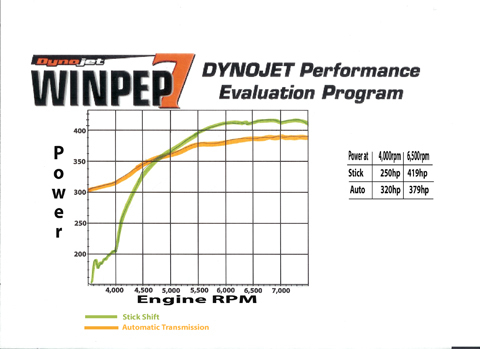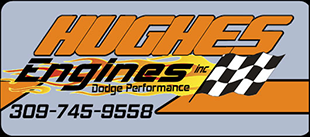It has come to our attention that many customers do not understand how power increases occur when modifications are made to their engines. Power increases are not like flipping a switch (like Mad Max you watch too much TV!!), other than N.O.S. They start small and build progressively to a maximum at a higher R.P.M., then decrease. See example below:
|
RPM
|
Original
Horse Power
|
Modified Engine
|
Increase
|
|
1000
|
100
|
100
|
0
|
|
1500
|
125
|
128
|
3
|
|
2000
|
150
|
158
|
8
|
|
2500
|
200
|
211
|
11
|
|
3000
|
250
|
265
|
15
|
|
3500
|
300
|
321
|
21
|
|
4000
|
315
|
338
|
23
|
|
4500
|
300
|
336
|
36
|
|
5000
|
280
|
321
|
41
|
|
5500
|
240
|
275
|
35
|
|
6000
|
200
|
220
|
20
|
|
6500
|
160
|
175
|
15
|
In the above example, the power increase would be considered 41 H.P. However, notice that the power increase of 41 H.P. is only at 5000 RPM. The power increases progressively up to 4500 RPM and decreases after that. Note that the maximum power point is 338 H.P. @ 4000 RPM, but the max power increase at 5000 is 41 H.P. It is the maximum power differential point. The difference is actually because the original power was falling off faster than with the modified engine, but it is still more power. This is a normal occurrence when modifying an engine.
The point of this article is that when the question of how much power will that part make is asked, it can be a very complex answer. The problem we see is that a lot of people think that a 30 H.P. increase starts at idle and is 30 H.P. at every RPM only in your dreams!
Not only that but another pertinent question is will the part or modification make the power where you want it? And this brings up another misunderstanding. Speaking of the part or the modification there aint none! Its the combination, the combination, the combination!!
One part or modification is rarely a big power gain, more likely is that it will cause you heart ache especially if it is wrong! You must remember to use or install a combination of parts or modifications that will work well together for what you want to do. Dont be led astray by magazine articles that hype parts that create fantastic power improvements. Speaking of magazines, you must understand that the magazines make money from the ads which are on their pages not what you pay for your subscription. One full page of advertising may be worth as little as $2000 up to $5000+ per issue depending on the magazine and whether it is a black and white or color ad. Naturally, the company that buys the most advertising will show up most often in tech articles and look the best in those articles funny how that works!
Another thing you must keep in mind is that any specific part you may add to your engine must compliment the parts or combination you have or you wont achieve the results you expect. An example of this can also be attributed to the magazine articles weve just referred to. We have also seen the tech articles or ads on camshafts or heads where the engine picked up a fantastic amount of power based on the installation of the magic part. However, if you carefully examine the combination of parts in the test engine you can see that the original combination of parts was obviously in need of the magic part and that it is not something that anyone with common sense would build.
Lets look at some examples of mismatched engine tests. First: a 500 stroker with 10.5:1 compression, 2X4 Tunnel Ram intake with a 284/290 @0.050 roller cam with stock 906 iron heads. This combination is crying for more head/air flow, so it is quite possible to see 100-150 HP gain with the addition of race heads; some that have 13.5/14:1 CR and flow about 80 to 100 CFM more air. Or, if we took the engine above with good heads, but a stock hydraulic or 484/284 cam YOWZERS! you might pick up 100 or more HP with a cam change, but who would be so lame as to build something like that? These advertisements/articles are a stacked deck not honest, but they sure look good!
Now if you are not confused enough or think it easy, let's muddy the water a little. Chassis dyno numbers; the accuracy or relationship of power outputs from one dyno to the next is close to non-existent. I would guess more arguments are now started based on chassis dyno figures than any other subject gearheads deal with. We have one customer who is not happy with our parts and service because his car does not chassis dyno as much as his buddy's car. Yeah, they each tested on different dynos and my customer is 6mph faster and .4 seconds quicker than his buddy in the 1/4 mile, but he is still not happy - duh! And you thought people would be reasonable if you told them the facts - yeah right! And that's not all; shown below are 2 chassis dyno curves. Same car, same engine, same rear axle, same dyno. The only difference was the transmission.
Test 1 was with a standard transmission.
Test 2 used an automatic transmission and torque converter with a 4000 RPM stall.

Note that the stick shift car with its positive coupling between the engine and axle showed a power curve we would normally expect to see. It starts out low and increases as the RPM goes up. The automatic, or more correctly the converter equipped car, multiplied the torque as it is supposed to do at the lower end and lost, or slipped, at the top end.
The stick car showed 250HP @ 4000 and 419HP @ 6500RPM while the automatic showed 320HP @ 4000 and 379HP @ 6500RPM. As a matter of fact the E.T.'s were similar and the stick car did show more miles per hour. If the axle ratio or tire size had been changed then the curves would have been different again. This example shows how each combination does its work differently.
The point here is that chassis dyno figures are good for testing purposes only. You cannot use the numbers from one dyno to the next. The Society of Automotive Engineers (S.A.E.) has recently instituted new engine dyno testing procedures for new car engines. There is now an independent 3rd party observer involved in the testing. Not that the factories would fudge the numbers any or forget to install the air cleaner, mufflers, and alternator just to sell a few more Corollas or Scions. Come on - get serious; who would do that? Ah yes, the horsepower race is alive and well. I love it!
Remember, an engine is basically an air pump, and the more air you can pump through it, the more power you are going to have. This is sort of like the a chain is as strong as its weakest link analogy; only in our case the engine is as powerful as its worst restriction to air flow that is our weak link.
Be careful when replacing parts in your combination; make sure they complement what you have or are building before you buy - and find out the hard way! | 


